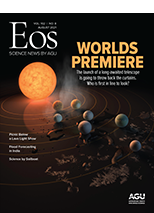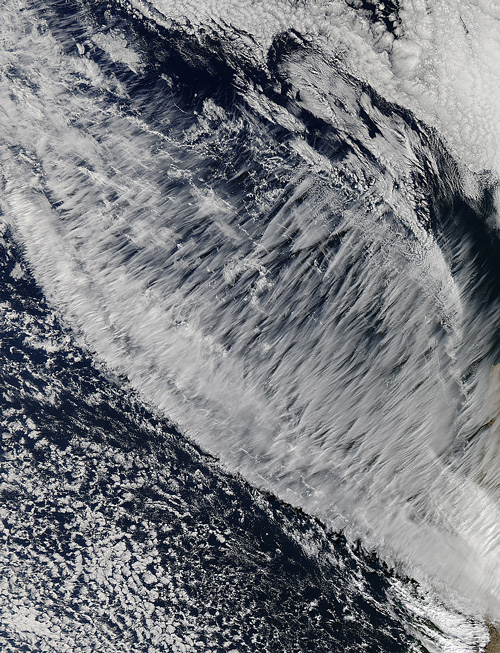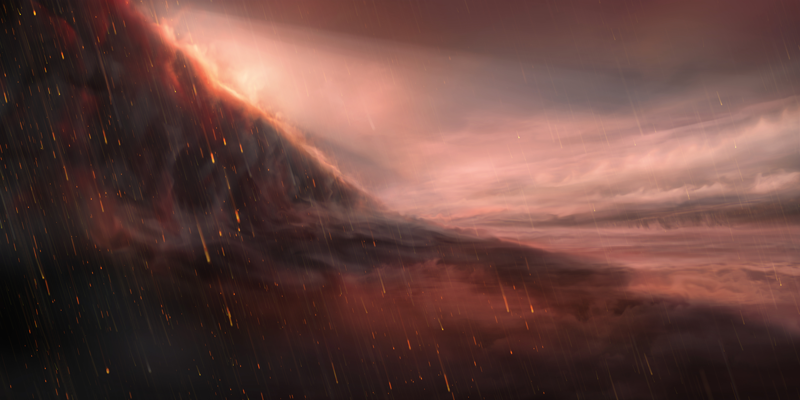New Telescope, New Worlds

• Exoplanets in the Shadows
• Overture to Exoplanets
• The Forecast for Exoplanets Is Cloudy but Bright
• “Earth Cousins” Are New Targets for Planetary Materials Research
• Oddballs of the Exoplanet Realm
• Thousands of Stars View Earth as a Transiting Exoplanet
• Taking Stock of Cosmic Rays in the Solar System
• Gap in Exoplanet Size Shifts with Age
• Unveiling the Next Exoplanet Act
The first time scientists measured the atmosphere of an exoplanet—a planet outside our solar system—they found something unexpected in the signal. It was 2001, and the Hubble Space Telescope was trained on HD 209458 b, a recently discovered gas giant roughly the size of Jupiter.
When astronomers looked for the presence of sodium in light waves shining through the planet’s atmosphere as it crossed in front of its star, there was a lot less of it than they thought there would be, said Hannah Wakeford, a lecturer in astrophysics at the University of Bristol in the United Kingdom. “From the very first measurement of an exoplanet atmosphere, there was evidence that something else was happening, something else was there blocking the light.”
The most compelling theory for what that something could be? Massive banks of dark, hot clouds. “Clouds are essentially liquid or solid droplets or particles that are suspended in a gaseous atmosphere,” said Wakeford. But because the planet is so hot—5 times hotter than Earth—those droplets couldn’t be made of water, as they are on Earth.
In the 2 decades since analyzing the atmosphere of HD 209458 b, astronomers have discovered more than 4,000 exoplanets. Using spectroscopy, they have measured the atmospheres of more than 100 of those objects, and it looks like many of them are cloudy. The way those extraterrestrial clouds behave and the exotic things they could be made of—liquid sand, iron, even rubies—are stretching scientists’ ideas of what terms like clouds, rain, and snow even mean in the context of the universe.
“Clouds are everywhere,” said Laura Kreidberg, an astronomer at the Max Planck Institute for Astronomy in Germany. “And to have any hope of understanding what’s going on in [exoplanet] atmospheres, we have to understand the clouds.”
Mushballs and Methane Lakes
The trouble is, clouds are complicated. Even on Earth, clouds are difficult to model (one reason weather forecasts can still lack accuracy.) Their complexity arises partly because they are simultaneously very small and very large: made up of microscopic water droplets yet so vast they can cover more than two thirds of Earth’s surface. Another reason is that there are so many kinds of clouds, and they behave in complex ways, explained atmospheric physicist David Crisp at the Jet Propulsion Laboratory, California Institute of Technology.
Clouds are “ubiquitous; they can form in many different kinds of environments, and there are many processes associated with their formation,” Crisp said.

And they’re not made only of water, either. Most cloud particles start growing on condensation nuclei—a speck of dust or a grain of salt. And although most earthly cloud droplets are spherical and liquid, those that make up cirrus clouds are hexagonal ice crystals.
Clouds can frustrate scientists’ ability to see clearly, whether they are gazing at the heavens from the ground or peering back at Earth from space. In the 1980s, Crisp helped build the camera in the Hubble Space Telescope and now leads a NASA team that uses orbiting satellites to measure the dangerous levels of carbon dioxide accumulating in Earth’s atmosphere. “I’ve learned to hate clouds from both sides now,” he joked.
Clouds mess with models predicting future climate change, he said, because they simultaneously warm and cool the planet, depending in part on whether their droplets are mainly liquid or mainly ice. In general, low-lying, mostly liquid clouds provide shade and reflect solar energy back into space, whereas high-altitude, frozen cirrus clouds trap infrared radiation emitted by Earth’s continents and oceans and intensify surface heating. This duality has long frustrated exoplanet cloud watchers, too—scientists scrutinize cloud signals to better understand how or whether clouds are heating the atmosphere below them.
Scientists are still trying to understand whether, at a global level, those cooling and warming effects cancel each other out and how that balance could change in the future. (One recent study even suggested that at carbon dioxide levels of around 1,200 parts per million, global cloud cover could become unstable and dissipate, dramatically accelerating warming.)
Despite the uncertainties, we know a lot more about Earth’s clouds than we do about those on other planets and moons of our solar system. It was only in the 1970s, for instance, that scientists figured out that Venus is enveloped in clouds of sulfuric acid. “This stuff will strip paint—and just about anything else,” said Crisp. Space missions to Venus have dropped mass spectrometers into the planet’s atmosphere that, “even though sulfuric acid is not very nice to our mass spectrometers,” have managed to send back data about the chemical makeup and concentrations of several cloud layers.
Jupiter’s atmosphere has been sampled too, and has been found to contain swirling ammonia clouds. Recent flybys of the tops of these clouds by NASA’s Juno mission identified mushballs—Jovian hailstones formed out of water-ammonia slush enrobed in an ice crust—that fall through the planet’s atmosphere. On the way down, these mushballs collide with upward moving ice crystals and electrify the clouds, causing shallow, high-altitude lightning visible from space.

Thanks to the Cassini spacecraft, we know that the atmosphere on Titan, the largest of Saturn’s moons, is largely made up of nitrogen, like Earth’s. There are seasons, monsoons, and wild windstorms. But Titan’s mountains are made of solid ice, and instead of a water cycle, it has a hydrocarbon cycle: On Titan, the rain, rivers, and lakes are made of methane and ethane.
But many questions remain when it comes to solar system weather. For example, we don’t know how deep into Jupiter the mushballs fall before they evaporate and rise again, said Wakeford. There are mysterious long-chain hydrocarbons floating high in the atmosphere of Titan too. “We have absolutely no idea how they got there; it’s baffling.”
What knowledge we do have is drawn from the briefest of snapshots, added Crisp. “We’ve dropped a few dozen probes into the atmosphere of Venus. But you know, if you measured Earth’s atmosphere with only a dozen instruments, how much would you know about the Earth? These planets are big places, and they have complicated climates—quite as complicated as ours.”
A Lead Blanket or Gems and Jewels
The challenges of analyzing extraterrestrial clouds are magnified when it comes to exoplanets. We can’t send a probe laden with instruments to any of them or record detailed images of their surfaces.
All we have is light, said Heather Knutson—the light coming from a far-off star. “We know there’s a planet in orbit around it, and we can indirectly infer some basic things about that planet, but it’s really a sort of poor man’s camera,” said Knutson, an astronomer at the California Institute of Technology
When an exoplanet passes in front of its star—an event called a transit—astronomers can measure the way light passes through the planet’s atmosphere on its way to us. Measuring how opaque the atmosphere is at different wavelengths of light (transit spectroscopy) offers clues to its composition. Kreidberg used an X-ray analogy to explain how it works: “Our bodies are opaque in optical light. If you shine a flashlight at a person, you can’t see through them. But if you look in the X-rays, you can see through the skin, but not through the bones.”
In the same way that our skin differs from our bones, molecules in planetary atmospheres are opaque or transparent at different wavelengths. “Whether it’s water or methane or oxygen or carbon dioxide, they have distinct opacity at different wavelengths of light,” said Kreidberg. “So if the planet looks a little bit bigger at a particular wavelength, then we can work backward from that to try to infer what’s in its atmosphere.”
But clouds get in the way of that process, said Knutson. “If we’re going with the X-ray analogy, clouds are sort of like a lead blanket over the planet. You see something that looks very featureless.”
Still, on the basis of the planet’s average atmospheric temperature—something astronomers can estimate from the brightness of the star and the planet’s distance from it—it’s possible to infer what those clouds are likely to be made of because of the varying temperatures at which different molecules condense from gas into liquid.
And the vast range of possible temperatures is something that distinguishes exoplanets from those in our solar system, said Nikku Madhusudhan, an astrophysicist and exoplanet scientist at the University of Cambridge. “Because of that vast range, you allow for a much wider range of chemical compositions [than in the solar system]. A lot more chemistry can happen.”

Here on Earth, with an average temperature of 290 K, clouds are made mostly of water. The atmospheres of some exoplanets, between 400 K and 900 K, are warm enough to condense salts and sulfides into clouds. At around 1,400–2,000 K (a third as hot as the Sun), we would expect to see clouds of molten silicates—the material that makes up the volcanic sand on some of Earth’s beaches and is used in the production of glass. On an even hotter planet like WASP-76b, which is estimated to reach 2,400 K, clouds are likely made of liquid iron. And the atmospheres of the hottest known exoplanets—giant, 2,500+ K ultrahot Jupiters orbiting very close to their stars—are the right temperature for clouds made of corundum, a crystalline form of aluminum oxide that forms rubies and sapphires on Earth.
“These are quite literally the gems and jewels that we have here on Earth forming clouds and lofted high into the atmospheres of Jupiter-sized worlds that are lit glowing from their star,” said Wakeford. She remembered walking through the Hall of Gems in London’s Natural History Museum after learning this, trying to imagine the crystals molten and forming clouds. “It just blew my mind.”
Metallic Monsoons
WASP-76 b made headlines in 2020 when a team of European researchers published a paper suggesting it had not only clouds of iron but iron rain as well.

Like our own Moon and many planets that orbit very close to a star, WASP-76 b is tidally locked, meaning one side of the planet always faces the star (dayside) and the other always faces away (nightside). Researchers found evidence of iron atoms in the atmosphere of WASP-76 b’s hotter dayside but not on the cooler nightside, which they argued meant that the iron must be condensing into liquid droplets as wind carries the atoms around the planet. “We see the iron, and then we don’t see the iron. So it has to go somewhere, and the physical process that we expect is rain,” said Kreidberg, who was not involved in the study. “This is some of the most convincing evidence I have ever seen for exoplanet weather.”
But Caroline Morley, an astrophysicist at the University of Texas at Austin, cautioned that the phenomenon could be more complex. Recent studies, including one co-authored by Kreidberg, have examined the microphysics of how iron droplets form, finding that the substance’s high surface tension means that it doesn’t easily condense from a gas to a liquid. There might be some other processes involved in WASP-76 b’s iron phenomenon, Morley said—perhaps the iron interacts with some other chemicals in the planet’s atmosphere, which helps it form a cloud.
“Statistically, I believe that there are exoplanets where it is raining right now,” she said. “But I think that we have not seen smoking gun evidence for rain on other planets yet.”
Crisp agreed. “Clouds we’ve detected. Rain and snow have not yet been detected—but I’d be surprised if they weren’t there. Those are logical outcomes of the systems we see.”
Metaphorical Meteorology
So when astronomers talk about possible rain on exoplanets, is it really what we would think of as rain? What do the concepts of rain and clouds even mean in the context of distant space? To some extent, it’s all a metaphor, said Wakeford.
On Earth, the terms rain, clouds, and snow all apply almost exclusively to one substance: water. “Water is one of the most amazing materials in the universe,” Wakeford said, but not all substances behave like water when experiencing differences in pressure or temperature. “So when we frame these very alien clouds and rain and snow in that [water-based] context, it puts things in our minds that aren’t exactly what the physics is.”
For instance, words like snow and hail can be a bit misleading when you talk about solid particles in an atmosphere that’s hotter than a lava flow. “I tend to use rain instead of snow,” Wakeford said, “because snow to us evokes a temperature, a coldness. Rain is something that can define many different types of conditions, whereas snow for us is very much a cold thing. And this is not what’s happening here on some of these planets that are so incredibly hot.”

Still, Wakeford thinks a smattering of poetic license is justified to bring the public along on the journey and capture people’s imaginations. “If you start by saying, ‘It’s raining drops of glass on these planets’—that’s a starting point. I can use that; I’ve got [your attention] now. Then we can build on that and get a deeper understanding.”
When it comes to actually doing the research, though, scientists should be both circumspect and open-minded, said Madhusudhan. Although it can sometimes help to extrapolate from what we’re discovering about Earth’s clouds to these faraway planets, for instance, it’s important to remember that these worlds are so exotic that it’s possible there are processes going on in their atmospheres that we haven’t even considered. “The biggest mistake we could make is to try to simplify the complexity of exoplanetary systems just to fit a narrative.”
We may go on to discover kinds of weather we don’t even have words for, said Madhusudhan. “We have to be open to the fact that the complexity in nature may greatly surpass our imagination at the present time.”
Peering into the Infrared
So far, everything we know about clouds on exoplanets has been based on what Madhusudhan calls indirect inference: “It’s a bit more real than philosophical but a bit less real than an actual observation.” But the launch of the international James Webb Space Telescope ( JWST) near the end of this year promises to give astronomers the chance to make direct observations of exoplanet clouds for the first time.
JWST will keep Earth between it and the Sun and is designed to look at the longer wavelengths of infrared light. “Planets are easier to study in the infrared,” said Knutson. The telescope will make faraway objects look brighter than they do in visible light and will be better able to detect molecules in exoplanet atmospheres. It should also advance our understanding of alien weather.
“When you go to midinfrared, the composition of a cloud droplet starts to matter—the way that it scatters light is different for different cloud species,” said Knutson. “So we might, for the first time, directly measure what the clouds are made of.”
Morley is leading a team that will use JWST to examine a cold exoplanet called WISE J085510.83−071442.5 to test for the presence of water ice clouds and see whether they are changing as the planet rotates, implying that there are storm systems and weather. “That would give us real evidence, for the first time, that there’s water ice forming in a planet outside of the solar system,” Morley said.
Wakeford, meanwhile, will have a chance to train the telescope on HD 209458 b, the very first planet that 20 years ago was assumed to have clouds of magnesium silicate. JWST will give her a chance to prove (or disprove) that assumption with direct measurements.
Overall, “I think we think about clouds more broadly than anybody has thought about clouds in human history,” said Morley. “And we’re just on the cusp of being able to get a huge amount of really detailed information about those clouds. It’s a really exciting time to be in this field.”
Author Information
Kate Evans (@kate_g_evans), Science Writer






